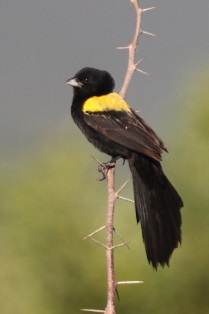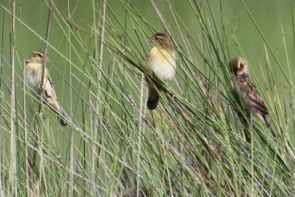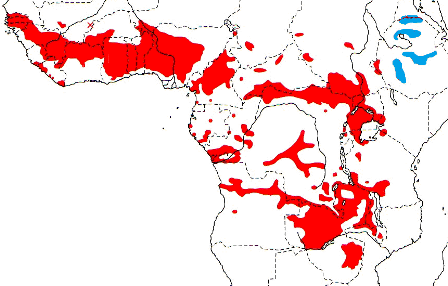Weaver Wednesday [98]: Yellow-mantled Widowbird 2014-04-30 (511)
 Weaver Wednesday
Weaver Wednesday


The Yellow-mantled Widowbird Euplectes macroura is widespread in African grasslands. The breeding male (photo right, by photographer Mike Buckham) is black with a yellow mantle and wing shoulder, and a long rounded tail. In Ethiopia, the yellow is only on the shoulder, but the similar yellow-shouldered subspecies of the White-winged Widowbird does not occur there. The Yellow Bishop male differs from the Yellow-mantled Widowbird in having a shorter tail, yellow rump and black mantle. The non-breeding Yellow-mantled Widowbird male has small yellow shoulder patches, and a longer tail than bishops in similar plumage. The female Yellow-mantled Widowbird does not have yellow shoulder patches but has yellow margins to the lesser and median coverts.
Three subspecies of the Yellow-mantled Widowbird are recognised (see map below, based on Birds of Africa):

E. m. macroura occurs from Senegal to Zimbabwe and extreme western Mozambique (see red on map).
E. m. macrocercus occurs in the highlands of Eritrea and Ethiopia (see blue on map). The breeding male differs from the nominate in having the mantle black (not yellow), and has a longer tail.
E. m. conradsi occurs on Ukerewe Island, in Lake Victoria. This subspecies is poorly known, and the type specimens have a longer tail than the nominate.
The Yellow-mantled Widowbird inhabits moist grassland, and marshy areas with trees and scrub. It also occurs in rice fields and rank grass in abandoned farmlands. It roosts in reeds or papyrus in swamps, or in thickets.
The Yellow-mantled Widowbird feeds mainly on seeds, especially of sedges, and also grass seeds. It also feeds on arthropods, including termites and their alates. The diet of adults is about 80% seeds and 20% arthropods. The Yellow-mantled Widowbird forages on the ground and in low vegetation, while termite alates are hawked in the air. It joins mixed-species flocks in the non-breeding season.
The Yellow-mantled Widowbird is polygynous, with up to five females per male. It is territorial, but in areas of high density it appears to be colonial. The male pursues females in flight, with his tail depressed in display. Experiments showed that male tail length affects territory defence, but not the attractiveness of the male to females.
The nest of the Yellow-mantled Widowbird is a large oval structure with a side entrance. The framework is woven into living grass blades by the male, and more successful mles build more nest frames. The female continues to add grass lining during incubation. The nest is placed 15-60 cm above the ground in grass, usually in damp areas. The 2-3 eggs are pale green, with heavy brown speckling. Incubation is by the female, and chicks are usually fed by the female. Nest failures are largely due to nests being trampled by grazing cattle or by grass-cutting.
There are no PHOWN records for the Yellow-mantled Widowbird (see PHOWN summary), and many are needed of this widespread species. Also look at old nests which may be taken over by Zebra Waxbills Amandava subflava. Submit any weaver nest records to PHOWN (PHOtos of Weaver Nests) via the Virtual Museum upload site.
PHOWN summary
Previous Wedn: Baya Weaver
Full weaver species list
| 

 Weaver Watch
Weaver Watch


